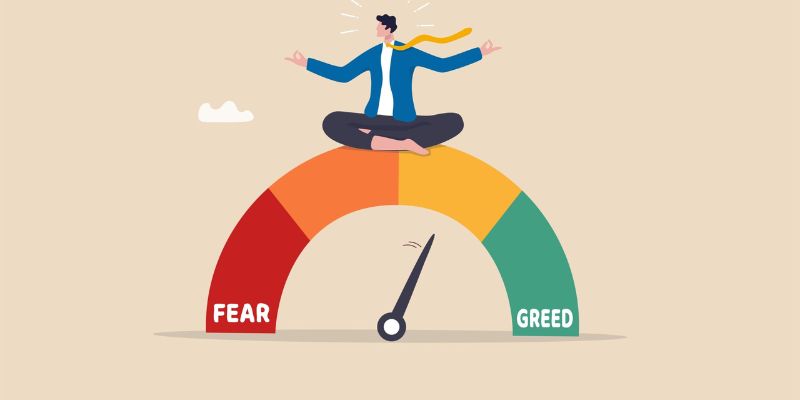Markets move, but what pushes them? Often, it’s not just cold, hard facts but the raw emotions of those trading. How investor fear and greed can impact market stability is a critical factor many overlook. Fear and greed drive prices up and down like a seesaw. When fear grips the market, investors sell. They dump stocks, sending prices tumbling. On the flip side, greed can inflate prices past reasonable levels as everyone scrambles to buy. I’m here to show you how these twin forces work and what that means for your investments. Get ready to dive deep into the market’s emotional roller coaster and learn to ride it like a pro.
Understanding the Emotional Undercurrents in Investing
Identifying Emotional Investing Impacts
Fear and greed are big drivers in the stock market. They can make prices swing more than they should. Fear can cause big sell-offs. This can lead to crashes. On the other hand, greed can make prices go too high. This can cause bubbles. Bubbles often lead to crashes too when they burst.
It’s like a see-saw. Emotions push prices up and down. When too much fear or greed takes over, the see-saw can break. It’s risky for everyone. Investors, big and small, feel this risk.
We see fear in ways like panic selling. When bad news hits, people sell fast. They want to stop losing money. But this can cause a big drop in stock prices. It can hurt the market a lot. Some call it a ‘fear index’ when everyone acts scared. This index can show us how much fear is out there.
Greed works differently. It makes people buy too much. They think they can get rich quick. This pushes prices higher. But if the prices get too high, they may crash down hard later.
To avoid getting caught in these swings, we must watch our emotions. We can’t let fear or greed control our choices. If we do, we can lose money. We should invest based on facts, not feelings. This means we must know about things like ‘market sentiment analysis’. It tells us what most investors feel. If we know this, we can make better choices.
Analyzing Market Sentiment Trends
Now let’s talk about market sentiment trends. They show us the mood in the market. Are people happy or scared? It’s like checking the weather before leaving home. Knowing this can help us plan our day.
Market moods can change fast. One day, everyone is happy and buying. The next day, they might be selling in fear. These shifts can be hard to follow. But it’s our job to make sense of them. We use tools like ‘VIX analysis’ to measure this. The VIX is like a fear meter. It goes up when people are scared. It comes down when they calm down.
There’s also the ‘greed index metrics’. They look at how much people want to win. When greed is high, people might ignore risks. They keep buying, even when prices are too high.
It’s like following a crowd. Sometimes, it leads to good places. But sometimes, it leads to trouble. This ‘herding behavior in investing’ is risky. We must be careful not to just follow others.
Knowing about these emotions helps us. We can steer clear of crashes and bubbles. Plus, we can find chances to buy low and sell high. This is smart, not emotional, investing. It makes us better at handling our money.
Remember, the market has moods like people do. It can be calm or wild. By looking at the signs, we can prepare. We can protect our money from big swings. And we can make smart moves at the right time. It’s about being in control and not letting fear or greed win.

The Science of Fear and Greed in Financial Decisions
Fear Index Analysis and Investor Psychology
Fear grips investors hard. They freak out and sell stocks. This is fear-driven investing. The Fear Index, or VIX, tracks how scared stock market players are. When VIX spikes, you know fear rules the market. This fear can push stock prices down quick. Let’s get why this happens.
Fear in investing comes from worry. People worry about losing cash. So they sell. When lots of folks sell, prices drop. It’s like a stampede. One starts running, soon all bolt. In the stock world, this means less stability. Stocks go up and down a lot. That’s why getting a handle on fear matters. It helps investors stay calm and avoid big sell-offs.
Greed Index Metrics and Their Influence on Asset Bubble Formation
Greed can be just as mean as fear. It heats up when stocks soar. When everyone wants in, that’s greed in action. We call this irrational exuberance. Crazy, huh? But greed can puff up asset bubbles – think housing crash in 2008.
Greed index metrics show when greed’s too high. It’s like a meter for how much people chase gains. When the meter hits red, we’ve got too much greed. People buy, buy, buy, hoping for quick cash. Trouble is, things can’t always go up. Sometimes, they crash hard. Boom – bubble pops.
Greed leads to buying too much at sky-high prices. But when reality hits, everyone dashes to sell. Prices plummet. Those who joined the greed game late? They lose big.
Investor psychology plays a huge role in this dance of fear and greed. Know how you react to market swings. It can save your wallet. Fear and greed make markets sway. Wise investors watch these emotions – in others and themselves. Spotting fear and greed can guide you to make better choices, even when others around you lose their cool.
So, here’s the deal. Get fear and greed’s number. Learn how they mess with market stability. It can help you buy and sell smarter. Not let panic or greed lead you. Stay in control, and you could do well, even when markets go wild. Remember, in stocks, cool heads often win. Don’t follow the crowd. Think, then act. Your future self will thank you.

Behavioral Finance: Herding, Overreactions, and Market Volatility
Herding Behavior in Investing and its Consequences
We all feel safer in a group – that’s human nature. But when it comes to investing, this herding behavior can shake the market’s stability. Imagine a flock of sheep. One spooks and suddenly, they’re all dashing in one direction. In the stock market, when folks see others buying or selling stocks, they often follow. They may think, “If everyone’s selling, this stock must be bad,” or “If they’re buying, I’m missing out!”
This group think affects prices and can cause big swings up or down. It leads to market bubbles when prices soar too high and crashes when they tumble down. Think of the tech bubble in the 2000s. Investors kept buying tech stocks just because others were, and prices shot up. But when folks realized many companies weren’t worth their high prices, a crash followed. Herding can make markets move far from where they should be based on the real value of companies.
How Irrational Market Behavior Contributes to Stock Market Volatility
Now let’s talk about market ups and downs caused by irrational behavior. This means investors aren’t always cool-headed number crunchers. They’re people with hopes and fears. Big news or a hot tip can make them overreact. They might dump a good stock on bad news or rush to buy on a hunch, even with no solid facts.
These wild swings – we call it volatility – make the market a bumpy ride. A high fear index, like the VIX, shows that folks are scared. When it spikes, it means people expect big market moves. The greed index tracks when people are too confident, which can signal a bubble.
Strong feelings like panic, fear of missing out (FOMO), or over-the-top optimism can lead to poor choices. Panic selling might feel right for one person, but if many do it, it can crash a stock’s price. On the flip side, too much FOMO and optimism might puff up a stock past what it’s really worth.
When lots of people buy or sell with their gut instead of facts, it’s a bit like a wild party on a boat. It might be fun at first, but if things get too crazy, it can tip over. And when a boat tips, everyone gets wet. Quick changes and mood swings in investing can toss around stock prices, making the market less stable.
Knowing this, it’s vital to manage those investing emotions. Keeping a level head can help you make better choices and might even let you profit from others’ panic. If you can stay calm and think things through when everyone else is running wild, you could find good deals on stocks that are unfairly low. But it takes guts and a good look at the real facts, not just following the crowd.

Strategies for Navigating Sentiment-Driven Markets
Trading Emotion Management and Mitigating Market Overreaction
Let’s talk feelings and money. Ever notice how fear and greed can make markets go wild? When investors get scared or too greedy, they can make choices that cause big ups and downs in stock prices. This is called “market sentiment,” and it’s important to know what it’s doing. I study these emotional tides and help people make better choices, even when everyone else is getting caught up in the moment.
So, what can you do when others panic or get too eager? First, watch the “fear index,” or what pros call the VIX. It shows how much fear is in the market. When this number jumps, it’s a sign people are scared, and markets may swing a lot. Next, keep your own fear in check. This means no rush selling when things look bad. Take a breath, wait, and think things through. Sometimes, the best move is not to move at all.
Greed can be just as tricky. It feeds “bull markets,” where prices go up a lot. But too much greed can make “bubbles” in prices. Then, when the bubble pops, prices crash fast. You’ve got to be careful not to get too excited and buy just because everyone else does. Before jumping in, ask: “Is this choice smart or just hype?”
Capitalizing on Market Volatility Through Contrarian Investment Strategies
Now, let’s flip the script. How about making the most of these wild market swings? That’s where “contrarian” strategies come in. A contrarian investor often does the opposite of the crowd. When others sell in panic, a contrarian may see a chance to buy good stocks cheap. And when others get greedy, a contrarian might sell stocks that are too pricey.
But it’s not just doing the opposite. It’s about staying cool and looking at the facts. Is a stock really worth its price? What’s going on in the company? What do the numbers say? A good contrarian takes time to dig into the details and make their own path.
Remember, it’s not easy to stand alone against the crowd. But history shows that it can pay off if you’re smart about it. Fear and greed make people follow each other, like a herd. But if you can manage your own emotions and think for yourself, you might just outsmart the herd.
In short, keep an eye on fear and greed with smart tools like VIX. Stay calm when others aren’t. And think about trying some contrarian moves. It’s not just about luck; it’s about making good choices even when the market feels like a roller coaster.
In this post, we dived into the heart of investing—our emotions. We looked at how feelings sway our choices and shake up the market. We saw fear and greed play tug-of-war in our financial picks. Understanding these feelings can help us make smarter moves.
We also explored how people often move in packs, like sheep. This herding can cause big market swings. It’s not just about the numbers; it’s about how we react to them.
Lastly, we talked about keeping cool when markets go wild and using these ups and downs to our advantage. Smart strategies help us ride out the storms and could lead to better gains.
Investing isn’t just about money. It’s a game of emotions too. By knowing this, we can play better and keep our cool when things heat up. Use the insights from this post to stay sharp and make wise moves in the market.
Q&A :
How do investor fear and greed affect market stability?
Investor psychology plays a pivotal role in financial markets, with fear and greed being two dominant emotions. When investors are fearful, they may sell assets, leading to market declines and increased volatility. Alternatively, greed can drive excessive buying and asset bubbles. Both extremes can disrupt market equilibrium, leading to instability.
What are the indicators of fear or greed in the market?
Identifying the mood of the market can be observed through various indicators. The Volatility Index (VIX), often referred to as the fear index, measures market risk and investors’ sentiments. On the other hand, the Bull/Bear Ratio gauges investor optimism versus pessimism. High volume trades and sharp price movements might also signal these emotional extremes.
Can understanding investor emotions improve investment strategies?
Yes, being aware of the emotional climate in the markets can significantly refine investment strategies. Savvy investors might use emotional extremes as contrarian indicators; when fear is high, it might present buying opportunities, whereas when greed is soaring, it could be a signal to take profits or exercise caution. Emotional awareness can lead to more disciplined and potentially lucrative investment approaches.
What is the ‘fear and greed index’ and how is it used?
The ‘fear and greed index’ is a tool that attempts to measure the prevailing sentiment in the market by analyzing different data points such as market momentum, stock price strength, and safe-haven demand. It is used by investors to gauge whether the market at large is feeling fearful or greedy, providing insights into potential market turns or continuity.
How can investors protect themselves from the pitfalls of fear and greed?
Investors can shield themselves by adopting a long-term perspective and a disciplined investment strategy that includes diversification and regular portfolio rebalancing. Setting predefined rules for buying and selling, relying on fundamental analysis, and avoiding the temptations of market timing based on emotional sentiment can also help maintain stability in their investment approach.



